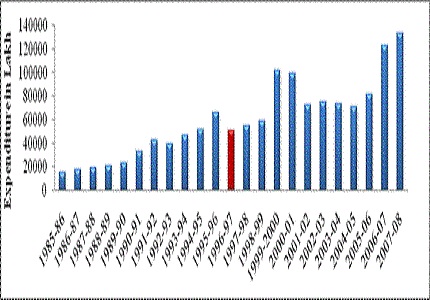Reproductive and Child Health Programme in Bihar, India: Does Expenditure Matters to Performance?
Abstract
Since the launch of the reproductive and child health policy regime in 1998-99, there has been a massive rise in government expenditure on family welfare programmes in Bihar and national level. This paper makes a systematic effort to assess the performance of the family welfare programmes vis-à-vis trends in expenditure. The trends in key performance indicators for Bihar reveal that progress has been slow and limited in the post-RCH policy regime. Contraceptive prevalence coverage has accelerated, and the increased in the Child immunization and institutional delivery. Consequently, the pace of reduction in the couple protection rate, total fertility rate and infant mortality rate has slowed. It is evidently clear that in the absence of suitable mechanism to operationalise of RCH programme, the exponential increase in expenditure alone cannot lead to commensurate a positive impact on key performance and outcome indicators. There is need suitable mechanism to operationalise RCH programme.
Downloads
References
2. Srinivasan, K, Chander Shekhar & P Arokiasamy. Reviewing Reproductive and Child Health Programmes in India, Economic & Political Weekly, 2007; Vol 42 (27), 2931-39.
3. Salunke, S & Sharad Narvekar. Target free Approach for Family Welfare: A Review of Experiences in Maharashtra, Government of Maharashtra; 1997.
4. Kothari, D et al. Vikalp – Managing the Family Planning Programme in the Post-ICPD Era: An Experiment in Rajasthan, India, 1997; IIHMR Occasional Paper No 2.
5. Ghasura, ND, BC Patel & ME Khan. Case Study: Implementing Target-free Approach in Gujarat, National Workshop on Target-Free Approach, Lucknow, 1997;24-25.
6. Mavalankar, DV. Paradigm Shift in India’s Family Welfare Programme: A Review of Target- Free Approach in Family Planning, unpublished document, Indian Institute of Management, Ahmedabad;1997.
7. Department of Health, Status of Health in Bihar, Government of Bihar; 2009.
8. Sangwan, N. and Maru, RM. The Target-Free Approach: An Overview” Journal of Health Management, 1999; Vol. 1, No. 1, 71-96.
9. Ministry of Health and Family Welfare (MoHFW), National Health Accounts 2001-02, National Health Accounts Cell, Ministry of Health and Family Welfare, Government of India, New Delhi,2005.
10. Srinivasan, K. Population policies and family planning programmes in india: a review and recommendations” Newsletter, International Institute For Population Sciences, Mumbai. Volume 47, No 1 &2 January 2006
11. National Population Policy. Department of Family Welfare, Ministry of Health and Family Welfare, Government of India;2000.
12. IIPS and Micro-International, 2007. National Family Health Survey (NFHS 3), 2005-06, International Institute for Population Sciences, Mumbai.
13. IIPS and Micro-International, 2000. National Family Health Survey (NFHS 2), 1998-99, International Institute for Population Sciences, Mumbai.
14. IIPS and Micro-International, 1993. National Family Health Survey (NFHS 1), 1992-93, International Institute for Population Sciences, Mumbai.
15. Ministry of Health and Family Welfare (MoHFW), Family Planning Year Book, 1986-2006, Ministry of Health and Family Welfare, Government of India, New Delhi.
16. India Office of the Registrar General & Census Commissioner. Compendium of India's Fertility and Mortality Indicators, 1971-2007: Based on the Sample Registration System (SRS), Registrar General, India; 2009.
17. Madhav, DG. PHC in Rural Bihar: Gaps in Infrastructure and Service Delivery. (G. L. Forgia, Ed.) India Health Beat, 2010; 3 (6), 4.

Copyright (c) 2014 Author (s). Published by Siddharth Health Research and Social Welfare Society

This work is licensed under a Creative Commons Attribution 4.0 International License.


 OAI - Open Archives Initiative
OAI - Open Archives Initiative


